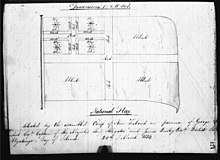Flag of the United Tribes of New Zealand
The flag adopted by the United Tribes in 1834 had black fimbriation around the canton cross,[1] though it was changed to white shortly after, following the rule of tincture.
[8] In traditional Māori culture, the trifecta of colors hold symbolic significance: vitality and life force (red), peace, light and spiritual connection (white), and the ocean as well as spiritual connection between the people and environment (blue), inter alia.
Busby reasoned a flag would resolve the issues with Australian customs authorities, and give the Māori a sense of collective nationality.
Macleay suggested his own design with nine alternating stripes of blue and white with a Union Jack in the canton, but Busby declined to include the flag in the later vote, deeming it to not have enough red, a colour favored by the Māori.
Busby recruited the head Church Missionary Society reverend Henry Williams to create the designs.
[23] In May of that year, while the treaty was still being distributed around the country, Hobson received word that Te Kara was being flown by the New Zealand Company, a commercial enterprise with a business model based on systematic colonisation.
[24] A similar incident occurred on 30 June when Hobson sent an armed party to remove Te Kara from a flagstaff in Petone.
[3] The replacement of the New Zealand flag by the Union Jack became a point of contention among the Māori, many of whom were becoming increasingly unhappy with the outcome of the Treaty of Waitangi.
Hōne Heke, a rangatira who was the first to sign the treaty, had been assured by the flag designer Henry Williams that the document protected the authority of the Māori leaders.
[25] Expecting the Māori would have equal status with the colonial government, Heke believed Te Kara should fly alongside the British flag.
Hobson did not meet with the Māori party at the appointed time, and the colonial powers at Russel raised the British flag on the staff once again.
[35] Te Kara gained a resurgence in use from the 1970s to the turn of the 21st century, in conjunction with the modern Māori protest movement.
[40][41] Researchers studying COVID-19 misinformation in New Zealand associated Te Kara's presence in the demonstrations as consistent with the overall increase in the number of white supremacists using Māori culture to promote their agendas.
[46] Linda Munn, an activist involved in the creation of the national Māori flag, said Te Kara 'represented the patronising control that Pākehā [non-Māori or white New Zealanders] have always sought to exert over Maori independence.’[47] Other criticisms highlight the fact that the rangatira at the vote only represented a small contingent of New Zealand's Māori population.
Contemporary New Zealand politician Jerningham Wakefield argued the consideration of a flag wasn't 'even known to any of the native tribes out of the small peninsula which forms about a twelfth part of the country.





